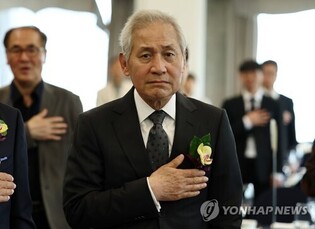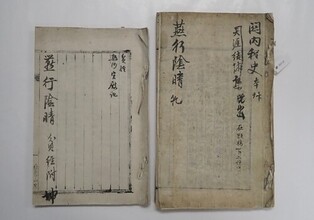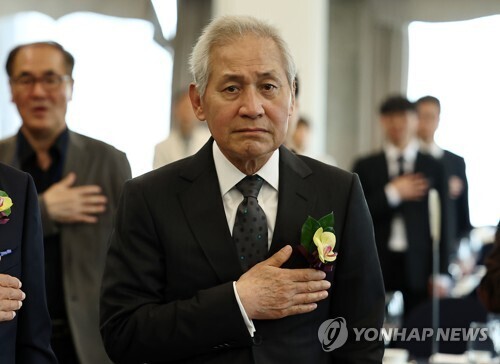
Returning to Khuzhir in a UAZ, switching to a Korean-made bus, and traveling about 40 minutes along the Angara River leads to a riverside village called Listvyanka. From there, a boat crosses to the port of Baikal. This boat drops off passengers at a small station of the Circum-Baikal Railway on the opposite shore.
At the mouth of the Angara River, where the immense waters of Lake Baikal flow out, there is a large rock protruding from the vast expanse where the river and lake meet, resembling a sea. Since the construction of a dam on the Angara, the lake’s water level has changed frequently, making the rock sometimes appear as two massive formations and at other times as a single smaller one.
There is a story behind why this rock is called the "Rock of Love." Lake Baikal, an enormous body of water, is fed by 336 rivers, yet there is only one river through which its waters flow out—the Angara.
According to Buryat legend, Baikal is the father, the 336 rivers are his sons, and Angara, the only outgoing river, is his only daughter. The father intended to marry off his daughter to the young Irkut, but Angara was in love with a northern youth named Yenisei. One day, without her father’s knowledge, she fled the lake to join her beloved.
Up to this point, the story resembles that of the foolish Ondal and Princess Pyeonggang. When Baikal discovered her escape, he threw a rock after her, striking her down. The tears Angara shed formed a great river that flowed 1,800 kilometers to the Yenisei River.
And thus, the rock became known as the "Rock of Love." However, another version of the tale suggests that this rock formation consists of the piled bodies of indigenous people who perished in this region, which lay along the conquest route of the Mongols and the expansion route of Imperial Russia.
The highlight of this railway journey is, without a doubt, the birch forests. In fact, one could say that traveling through Russia is essentially a journey to see birch trees. Birch trees have an aristocratic appearance.
Yet, when passing through an endless stretch of birch forest, it becomes almost unbelievable. Even spotting a single well-shaped, tall, thick-trunked white tree is a joy, but seeing them stretch endlessly makes it seem surreal. This is no exaggeration.
I once spent an entire night on an eight-hour overnight train from Moscow to Saint Petersburg, gazing at birch forests.
The white trees stretched endlessly, no matter how far the train traveled. It was especially beautiful at night.
Each time I woke up, there was the white forest again. And again, the white forest continued. The claim that Russian literature could not exist without birch trees now made perfect sense. In Japan, too, birch trees frequently appear in novels, poetry, and tanka. The word "shirakaba" in Japanese evokes a deeply romantic feeling.
Birch trees, with their elegant appearance, are widely used as ornamental trees, roadside trees, and for afforestation. However, due to climatic conditions, they grow only in the northern regions of Korea and do not become particularly large or thick.
In Finland and other parts of Northern Europe, birch is used to craft the highest-quality furniture and the finest interior materials.
This is, of course, because the trees grow very large and thick. Additionally, their texture is straight, and their color is beautifully refined.
The first thing that comes to mind when looking at birch trees is the Tripitaka Koreana. It is commonly believed that the wooden printing blocks of the Tripitaka Koreana were made from birch. However, the main panels were actually crafted from wild cherry, camellia, hornbeam, and maple. Birch was likely used as the crosspiece to prevent warping.
Because birch has a straight grain, it does not warp easily. In fact, it is so sturdy that it can prevent other woods from bending. Given that birch trees do not grow particularly large in Korea and are not very common, they were likely used sparingly and treasured all the more.
The next and most significant association with the birch tree is the fact that the image of the celestial horse, Cheonmado (天馬圖), found in the Silla tomb Cheonmachong (天馬塚), was painted on birch bark. The depiction of the celestial horse is generally said to reflect the influence of Scythian civilization. However, seeing similar images in Goguryeo murals suggests that the northern civilization connected by birch trees extended all the way to Silla, which is truly remarkable.
Come to think of it, the delicate, fluttering ornaments hanging from Silla’s golden crowns resemble the tiny leaves of the birch tree. The thick branches at the back resemble birch branches, while the san (山) shape at the front represents a deer’s antlers.
The Chinese characters for birch tree are baekhwa (白樺), and its bark is called baekhwa-pi (白樺皮). It is used as a medicinal ingredient for diuresis, pain relief, and fever reduction. Because its white bark peels off in thin layers, Russians have long used it to make various household items and crafts. The bark has purplish-brown spots, and when rolled up and burned, its resin crackles and pops as it burns slowly. The resulting scent is rich and deep, and the effect of its soft, warm glow was said to be beautiful.
They called it hwachok (樺燭), meaning “birch candle,” and it is said that the phrase “to light the wedding candles” originated from the tradition of lighting birch bark candles on the first night of marriage. Over time, the term was shortened to simply hwachok, giving birth to this beautiful episode.
Here, the Buryat people regard this tree as sacred, believing that it is inhabited by the spirits of the earth. They build their homes with it, burn it for firewood, and craft all kinds of household items from it. It is, in short, a tree that is deeply intertwined with daily life, almost like a spirit tree. Looking at it this way, the branches of these trees swaying under the night sky truly resemble spirits dancing in the wind.
To me, each of these birch trees looks like a tall, solitary sotdae (a traditional Korean totem pole). To the people here, too, these trees are ujumok (宇宙木), cosmic trees, and sacred. They are sinmok (神木), divine trees that connect heaven and earth. Particularly here in Baikal, as I see traces of the shamans who once lived here and their prayers, similar to the purpose of the sotdae, the birch trees appear just like them.
But this is not just a single sotdae rising toward the sky; it is a whole forest of them. It feels like a grand shamanic ritual performed by a group of shamans. Another pleasant sight is the occasional oak tree and the enormous red pine (hongsong, 紅松) clusters among the endless birch trees.
Though the trees here are massive, the landscape somehow resembles the mountains of Korea.
Birch trees do not grow well in Korea. They remain small and thin, overall weak and frail. And yet, Koreans love birch trees no less than anyone else. Perhaps it is due to a collective memory engraved in our DNA as a northern people.
Looking at the artificial birch grove planted around Cheongpyeongsa Temple on Munsusan Mountain during the Goryeo period, it seems clear that Koreans have cherished this tree for a long time. The fact that it is a Buddhist temple makes it even more fascinating.
However, this temple also had numerous meditation halls and Confucian-style lecture halls in its vicinity. It is difficult to say with certainty that the birch grove was planted solely by Buddhist monks. In the early days of Buddhism’s introduction, public resistance was strong, and there were many martyrs like Ichadon.
Perhaps those who planted the birch trees in this temple were not monks alone but a group of shamans who could not escape the collective memory of Baikal.
This tourist train does not have a set destination. It stops whenever it reaches a scenic spot, allowing passengers to explore before moving on. When it passes through a small village, it stops for a break. The villagers take this opportunity to set up small markets—not large bazaars, but simple roadside stalls.
In one village, I was able to enter a home, look around, and take photos. At another beautiful lakeside location, the train stopped so we could take a boat ride for a while. Along the railway, countless wildflowers bloomed in breathtaking displays, competing with one another for space.
Each flower engages in a fierce struggle for survival, displaying its own unique posture, color, scent, and movement.
An old song comes to mind: “Who do you bloom for?”
Since I am already thinking of songs, I begin to hum:
“Wild roses bloom red, in my southern homeland, atop a hill, a thatched-roof house, oh, how I long for it…”
I do not know why I suddenly think of my homeland in the South while traveling through this northern land. Everyone says that being here somehow feels warm and familiar, as if we are not in a foreign country at all.
Perhaps that is why this song came to mind.
 |
| ▲ A view of Siberia from the Eurasia Friendship Express, traveling towards Novosibirsk, Russia, in the early morning on July 22, 2015 (local time). The Eurasia Friendship Express train is scheduled to arrive in Novosibirsk, the transportation, science, and business hub of Siberia, later in the afternoon (local time). (Yonhap) |
After a long nine-hour train journey, I finally returned to Irkutsk and, at midnight, boarded the Korean Air flight that was waiting for us.
As soon as I found my seat on the plane, an overwhelming fatigue set in. I collapsed right there and began to dream once more of Baikal.
It was farewell. And again, that song came to mind.
“My unforgettable love, who sang the farewell song to me…”
(C) Yonhap News Agency. All Rights Reserved













![[가요소식] 베이비몬스터, 첫 북미 투어 다큐 공개](https://korean-vibe.com/news/data/20260102/yna1065624915971209_797.jpg)









